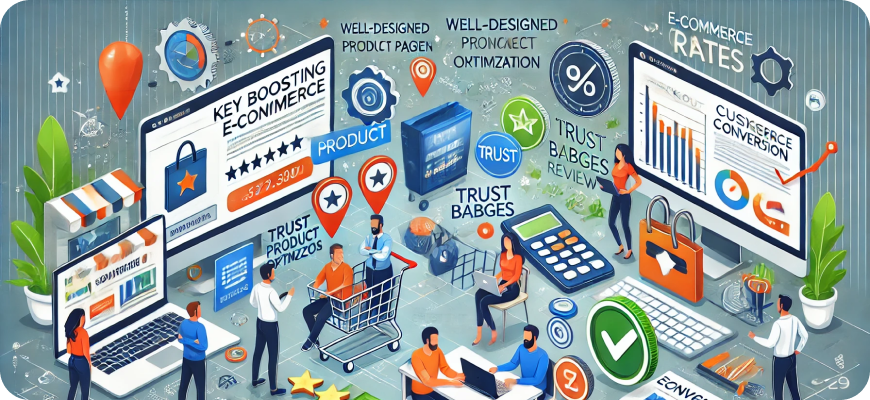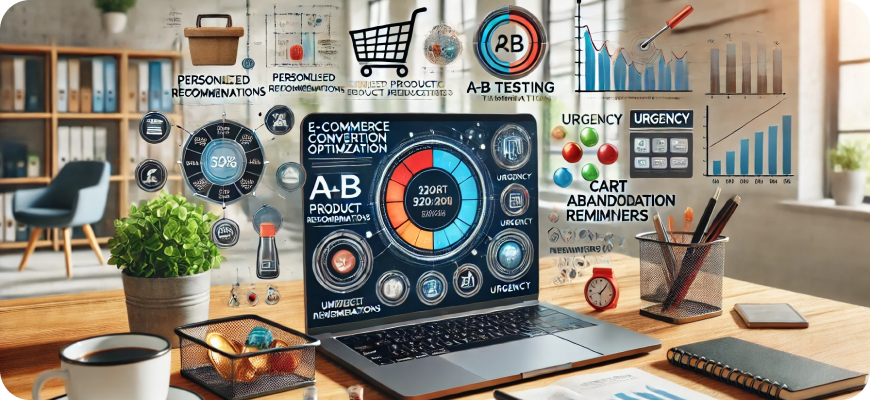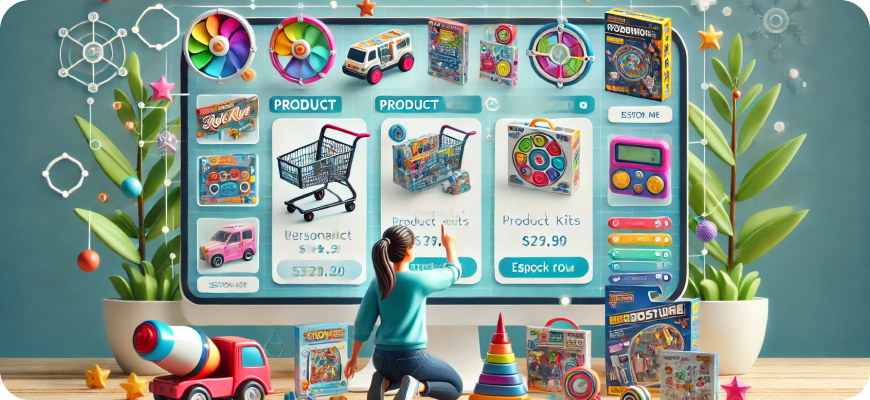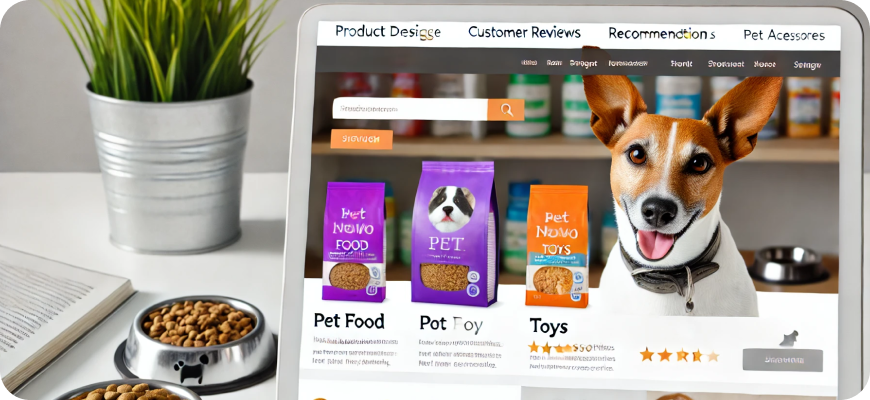How to boost your ecommerce conversion
For e-commerce businesses, conversion rate is a crucial metric that directly impacts revenue. While attracting traffic to your site is essential, turning those visitors into customers is the key to growth and profitability. Even small improvements in conversion rate can result in significant increases in revenue. From user experience optimization and targeted marketing to trust-building and data-driven strategies, a comprehensive approach to conversion rate optimization (CRO) can help your e-commerce store achieve its full potential. In this article, we’ll explore effective strategies to boost e-commerce conversion and provide actionable tips to drive higher sales.

1. Optimize User Experience (UX) on Your Website
A seamless user experience is one of the most effective ways to increase conversions. Visitors who enjoy a smooth and intuitive experience are more likely to complete a purchase.
How to Improve UX:
- Ensure Fast Loading Times: A slow website drives visitors away. Optimize image sizes, enable caching, and leverage content delivery networks (CDNs) to improve load speeds.
- Simplify Navigation: Clear, intuitive navigation helps users find what they’re looking for quickly. Use straightforward menu categories, filters, and a prominent search bar.
- Use High-Quality Product Images and Videos: Showcasing products with high-resolution images and videos from multiple angles gives customers a better understanding of what they’re buying, reducing hesitation.
Impact on Conversion:
A well-designed website with fast loading speeds and easy navigation keeps visitors engaged and improves the chances of conversion.
2. Improve Mobile Optimization
With a large percentage of online purchases made on mobile devices, having a mobile-friendly site is essential for e-commerce success.
Mobile Optimization Tips:
- Responsive Design: Ensure your website looks and functions well on all devices, including tablets and smartphones.
- Simplify the Mobile Checkout Process: Streamline checkout for mobile users by minimizing form fields and enabling autofill options.
- Use Clickable Buttons and Large Fonts: Make sure that buttons, fonts, and other interactive elements are easy to read and click on smaller screens.
Impact on Conversion:
A mobile-optimized website ensures that users can easily browse and shop on their devices, reducing friction and boosting conversion rates.
3. Enhance Product Descriptions and Information
Clear, detailed, and engaging product descriptions help customers make informed purchasing decisions. When customers know exactly what they’re buying, they’re more likely to convert.
How to Improve Product Descriptions:
- Highlight Key Features and Benefits: Make sure customers understand the product’s main features, benefits, and uses.
- Use Bullet Points and Headings: Break up descriptions into readable chunks, making it easy for customers to scan information.
- Include Size Guides, Materials, and Care Instructions: Providing detailed product information, such as sizing and care instructions, can reduce returns and instill confidence.
Impact on Conversion:
Effective product descriptions reduce uncertainty and help customers feel confident in their purchase, which can lead to higher conversion rates.
4. Simplify the Checkout Process
A complex or lengthy checkout process is one of the leading causes of cart abandonment. A streamlined checkout can significantly improve conversion rates.
Tips for Simplifying Checkout:
- Enable Guest Checkout: Allow customers to make purchases without creating an account, reducing friction for first-time buyers.
- Reduce Form Fields: Only ask for essential information to speed up the checkout process.
- Offer Multiple Payment Options: Provide a variety of payment methods, including credit cards, PayPal, Apple Pay, and Buy Now, Pay Later (BNPL) options.
Impact on Conversion:
A simple, efficient checkout process reduces cart abandonment and encourages customers to complete their purchase.
5. Build Trust and Showcase Social Proof
Trust is a critical factor in online shopping. Customers are more likely to buy from brands they trust and that others have recommended.
How to Build Trust and Social Proof:
- Display Customer Reviews and Ratings: Show authentic customer reviews and ratings on product pages. Positive reviews reassure customers about product quality.
- Add Trust Badges and Security Certifications: Display trust badges, SSL certificates, and payment security symbols to reassure customers of a safe shopping experience.
- Showcase Customer Testimonials and User-Generated Content (UGC): Highlight testimonials or share images of real customers using your products on social media or on your site.
Impact on Conversion:
Building trust and showcasing social proof increases customers’ confidence in your brand, making them more likely to complete their purchase.
6. Leverage Data-Driven Personalization
Personalization can have a profound impact on conversion rates. By tailoring the shopping experience to each customer’s preferences and behaviors, you can improve engagement and drive more sales.
Personalization Strategies:
- Use Product Recommendations: Suggest products based on browsing history, past purchases, or items frequently bought together.
- Send Personalized Email Campaigns: Use customer data to send targeted emails, such as personalized product recommendations, abandoned cart reminders, or exclusive discounts.
- Create Dynamic Content: Show personalized banners, offers, and product recommendations based on each customer’s demographics, location, or behavior.
Impact on Conversion:
Personalized shopping experiences make customers feel valued and understood, increasing their likelihood of making a purchase.
7. Implement Retargeting Strategies
Many customers may browse your site but leave without making a purchase. Retargeting helps you re-engage these potential customers and encourage them to return and complete their purchase.
Retargeting Tactics:
- Use Facebook and Google Retargeting Ads: Serve ads to customers who visited your site, reminding them of the products they viewed or offering incentives to come back.
- Send Abandoned Cart Emails: Remind customers of the items left in their cart and offer a discount or free shipping to incentivize completion.
- Leverage Dynamic Retargeting Ads: Show customers specific products they browsed or added to their cart, making the ads more relevant and engaging.
Impact on Conversion:
Retargeting keeps your brand top-of-mind, bringing potential customers back to your site to complete their purchase.
8. Optimize Pricing and Offer Discounts Strategically
Competitive pricing and discounts can help boost conversions, especially when used strategically.
Pricing and Discount Strategies:
- Offer Limited-Time Discounts: Create urgency by offering time-limited discounts that encourage customers to act quickly.
- Provide Quantity Discounts or Bundles: Encourage larger purchases by offering a discount for buying in bulk or creating product bundles.
- Use Dynamic Pricing: Adjust prices based on demand, competitor pricing, and customer behavior to stay competitive and maximize revenue.
Impact on Conversion:
Strategic pricing and discounts make products more appealing and encourage customers to take action, boosting conversions.
9. Create a Loyalty and Rewards Program
Loyalty programs incentivize repeat purchases and encourage customers to return, helping to boost conversion rates in the long term.
How to Create an Effective Loyalty Program:
- Offer Points for Purchases: Reward customers with points for each purchase, which they can redeem for discounts, free products, or special perks.
- Introduce Tiered Rewards: Implement levels (e.g., Bronze, Silver, Gold) to reward loyal customers with exclusive benefits.
- Send Personalized Rewards and Offers: Tailor rewards and offers to customer preferences to increase engagement and loyalty.
Impact on Conversion:
Loyalty programs foster long-term relationships, increasing the likelihood that customers will return and make additional purchases.
10. Test and Optimize with A/B Testing
A/B testing allows you to test different elements of your website, marketing campaigns, and checkout process to see what performs best.
Elements to Test:
- Product Page Layouts and CTAs: Test different designs, CTAs, and layouts on product pages to see which leads to higher engagement and conversions.
- Landing Pages and Ads: Experiment with different ad creatives and landing page designs to find the most effective approach.
- Pricing and Discounts: Test different discount levels and promotional structures to determine which approach drives the most conversions.
Impact on Conversion:
A/B testing helps you make data-driven decisions, continuously improving your site and marketing efforts to boost conversions.
11. Highlight Free Shipping and Easy Returns
Shipping costs and return policies are major factors in online purchasing decisions. Offering free shipping and easy returns can boost customer confidence and encourage conversions.
How to Implement:
- Provide Free Shipping Over a Certain Amount: Offer free shipping on orders that exceed a specific threshold, encouraging larger purchases.
- Clearly Display Shipping Costs Upfront: Make shipping costs clear early in the shopping process to avoid surprises at checkout.
- Simplify the Return Process: Provide clear, easy-to-understand return policies and consider offering free returns to reduce hesitation.
Impact on Conversion:
Free shipping and hassle-free returns reduce the perceived risk of shopping online, making customers more comfortable completing their purchase.
12. Offer Multiple Payment Options
Having multiple payment options reduces friction at checkout, allowing customers to pay in their preferred way.
Payment Options to Consider:
- Credit and Debit Cards: The most common payment method and essential for any e-commerce store.
- Digital Wallets: Include options like PayPal, Apple Pay, and Google Pay for a quicker checkout.
- Buy Now, Pay Later (BNPL) Options: Integrate BNPL services like Afterpay or Klarna to appeal to customers who prefer paying in installments.
Impact on Conversion:
Offering diverse payment options makes checkout easier and more convenient, improving conversion rates by accommodating different customer preferences.
13. Build a Sense of Urgency
Urgency can motivate customers to act quickly, driving more immediate conversions.
Tactics to Create Urgency:
- Limited Stock Alerts: Show when products are low in stock to encourage customers to buy before they run out.
- Countdown Timers for Sales: Use timers on product pages or during checkout to highlight limited-time discounts.
- Highlight Fast Shipping Options: Emphasize express shipping options or deadlines for guaranteed delivery, especially during peak seasons.
Impact on Conversion:
Creating urgency encourages customers to act now rather than later, reducing hesitation and increasing the likelihood of conversion.

Conclusion
Boosting e-commerce conversion rates requires a strategic and holistic approach that prioritizes user experience, personalization, trust-building, and convenience. From simplifying the checkout process and optimizing for mobile to leveraging data-driven personalization and retargeting, each strategy plays a critical role in turning visitors into loyal customers. Implement these proven techniques, continuously test and optimize, and focus on building long-term relationships with customers to maximize conversions and drive sustainable growth for your e-commerce business.






